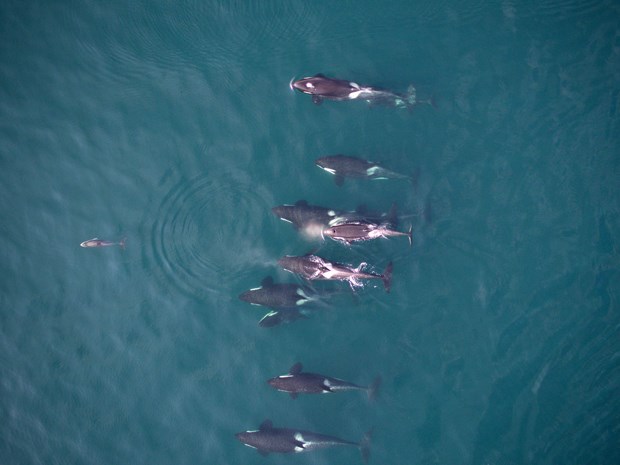A North Vancouver scientist and whale researcher is hoping that information gathered on endangered whale populations using drones will prove key to policy that will help protect the marine mammals.
Lance Barrett-Lennard, head of the Vancouver Aquarium’s marine mammal research program, spent a second summer this year taking high-resolution photographs of northern resident killer whales from above, using a custom-built drone.
The work is part of a joint pilot project with the U.S. National Oceanic and Atmospheric Administration’s Southwest Fisheries Science Center, to use the technique to gauge the whales’ health.
“They can look pretty good from the side and still be quite thin,” said Barrett-Lennard. “We need that top view to really be able to tell what’s going on.”
The high-resolution images can detect changes in the whales’ widths within a few centimetres, giving researchers a good idea of how much food they’re getting. The images also allow researchers to detect pregnancies early on in the whales’ 17-month gestation to help track miscarriages and young calves that don’t survive.
The pilot begun in northern coastal waters last summer was so successful that in September the research team expanded the project to look at the population of critically-endangered southern resident killer whales, which live in the Strait of Juan de Fuca and southern portions of Georgia Strait.
That population, which relies on chinook salmon, is down to only 82 whales, said Barrett-Lenard – about half what the population was 40 years ago. “They have declined substantially,” he said. “We think that food is part of it.”
Commercial boat traffic in the area and chemical contamination caused by runoff from nearby cities is also thought to play a part in making the whale population vulnerable. But the research this year shows there is also reason for hope.
“We found they were in reasonably good shape from what we could see,” he said – likely because it was a good year for chinook salmon.
The whales also demonstrated a lot of social behaviour like rolling and breeching. “When you see those kinds of behaviours, we know they have energy to burn.”
Five whale calves were also born in the past year to the population, including one during the research project. “We saw it within a day or two of it being born,” said Barrett-Lennard.
The custom-made drone, which is designed to be especially quiet and takes pictures from about 30 metres above the water, doesn’t seem to bother the whales, said Barrett-Lennard.
“I’m not an advocate for the wholesale use of drones to fly over wildlife,” he said. “But if you do it carefully with a very quiet drone it can be very, very useful.”
While the project’s goal was to gather scientific information, one of the unintended bonuses was “we were surprised at how beautiful the pictures were,” said Barrett-Lennard.
Researchers observed “all kinds of social behaviour we weren’t really intending to look for,” he said – including the whales’ habit of sharing the fish they catch. “What we saw from the air is pretty much every time they caught a fish one whale would carry it around for a while and take a bite and hand it off to another one…We never once saw them catch fish and eat it right away.”
Eating, for the whales, appears to be a social ritual similar to the way it is for humans, he said.
Social behaviour was also evident in the whales’ tendency to swim very close together. “Although they are these big versatile predators they are very much dependent on each other,” he said. “They swim close enough to touch most of the time. They really care about their membership in the group and the composition of the group.”
Project leaders hope their information will help pinpoint which salmon runs are crucial to the population’s survival. That can guide fisheries policy on both sides of the border, said Barrett-Lennard, to better time commercial fishing openings and boost salmon enhancement projects.



